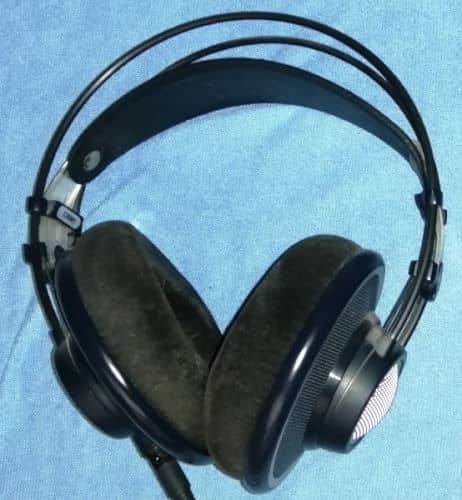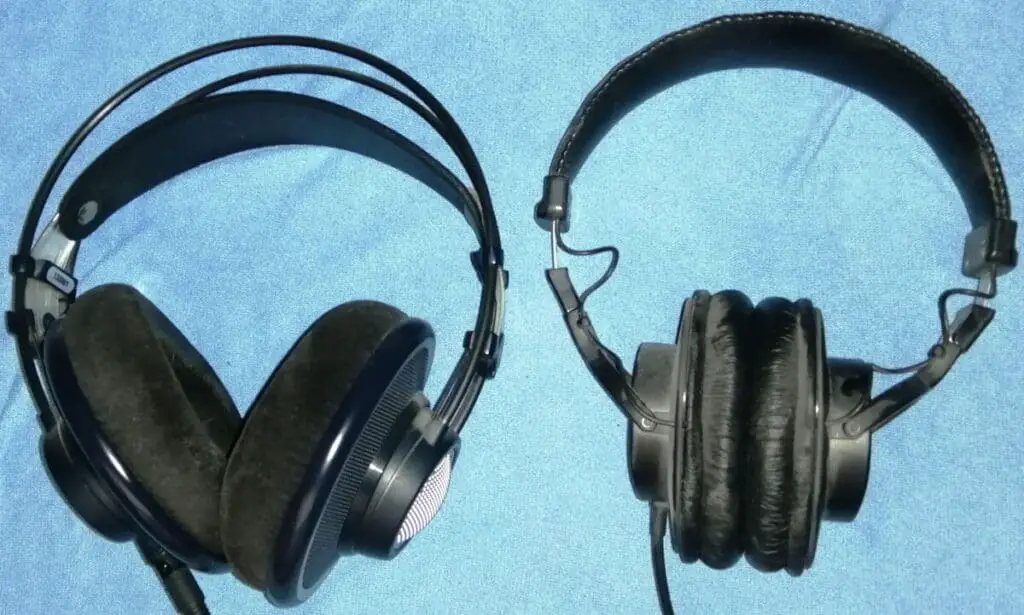I have been using a good set of open-back headphones for editing, mixing and mastering for many years in my home studio. These headphones rarely get used while recording though, as there are a few issues that may stop you from getting the very best results.
You can record using open-back headphones, but are likely to have issues with bleed straight back into the microphone. If you’re not using a mic e.g. you’re DI’d straight into your interface, this is not a problem. When using a microphone, open-back headphones are not recommended for recording.
Why get a pair of open-back headphones at-all then, and why not just get a pair of closed-back ones? Well, each has their advantages and disadvantages, and they both excel in certain situations.

If you are interested in checking out the best recording gear such as audio interfaces, studio monitor speakers, microphones, etc., you can find them at Amazon by clicking here.
What are open-back headphones?
Open-back headphones are what the name suggests; the backs of the headphones are open to their surroundings, allowing air to pass between those surroundings and the ears of the listener. This means that a significant portion of the sound will escape from the headphones, into the atmosphere around them and allow anyone close by to hear at least some of the sound.
Contrast this with closed-back headphones, where the backs of the headphones are completely closed. Although some sound can escape outside the headphones, especially at higher volumes, in practice very little of the sound does escape into the external environment.
To tell the difference, look at the back of the ear cups – the parts that sit on the ear. This will usually be solid plastic on closed-back headphones, whereas on the open-back variety it will be a grill, full of small holes that you can clearly see through to the small speakers in the ear cups.
By this point, you may be starting to realize the issue with recording using open-back headphones; some of the sound will escape from the back of the ear cups and leak back into the microphone. This is commonly known as bleed.
Say you are recording a vocal track, and there is a click-track in the project to keep everyone in time when tracking. You record a great vocal performance, but you play it back and under the vocal you can hear a click-click-click-click noise, ruining an otherwise excellent take. So for recording using a microphone, open-back headphones are not recommended.
For recording using a microphone, closed-back headphones are the best choice
Now for the case where you are not recording using a microphone; maybe you are recording a guitar, bass, or keyboard plugged directly into your interface. In this case, open-back headphones will perform well.
So why do open-back headphones even exist then? Aren’t headphones supposed to keep the sound going into the listener’s ears and prevent anyone or anything around them from hearing it – isn’t that the whole purpose of headphones?!
The answer is to do with sound quality and accuracy. If you think about it, headphones are basically two small speakers strapped onto your head, directly on your ears. This is not a natural way to listen to music! This affects what you hear in a few different ways….
- You get a build-up of bass frequencies at this close range
- The stereo spread is unnaturally emphasized
- All (well, most) of the sound is kept close to your ears
- None of the room ambience plays any part in the sound
Closed-back headphones emphasize these issues. Because very little sound escapes and very little can get in from the outside, you get a particular characteristic of sound that is very different from listening in a room on good quality speakers.
Open-back headphones go some way to combating these issues. As they are open to the environment, they let some of the room in and some of the sound escape. This is much like listening to music on speakers, where not all of the sound is going directly into your ears and the characteristics of the room contribute to what you hear. You also get some bleed between left and right ear cups, just like when in a room – your left ear doesn’t hear just the left speaker and the right ear hear just the right.
The resulting effect is that the open-back headphones are more accurate, have greater clarity and will give you a more natural sound.
What are open-back headphones used for?
Because of their more accurate representation of the sound, open-back headphones are an excellent choice for mixing.
The ideal choice for listening on while mixing is a pair of good quality reference monitor speakers, in an acoustically treated room. However most of us (including myself) don’t have access to that kind of high-end setup. A good set of open-back reference headphones can be the next best choice.
Open back headphones are as close as you can get with headphones to listening on speakers in a room. The space between instruments and the combination of frequencies will be much more accurate than with the closed-back variety, and be closer to the sound of the instruments as originally recorded.
You may hear some people advise that you should never mix on headphones. I disagree with this, and I have achieved great results mixing on my open-back reference headphones. I feel that unless you have an ideal listening environment, open-back headphones actually offer an advantage in that you don’t have to worry about listening position – they give you consistency wherever you are in your room.
This is a complex and somewhat controversial topic! That is why I wrote my guide on why it’s considered bad to mix on headphones. I highly recommend reading it to get a balanced view if you are considering mixing using a pair of headphones.
Should I get open-back headphones or closed-back headphones?
If you can only afford one pair of headphones and you record a lot using microphones, get a pair of closed-back headphones.
If you don’t ever record using microphones and instead always record via a DI into your interface so bleed is not an issue, get a pair of open-back headphones.
If you have the money, the ideal situation is to have two pairs of headphones; a closed-back pair for tracking/recording, and an open-back pair for mixing. This is exactly how I have been working for many years. I think the extra money is worth it to not have to worry about bleed at the recording stage, and for the extra accuracy and clarity whilst mixing.
Are open-back headphones better for your ears?
As some of the sound escapes out into the environment out of the back of the ear cups, open-back headphones can be better for your ears. All the pressure from the sound is not going straight into your ear like it does with closed-back headphones.
However, this advantage is completely cancelled out if you turn up the volume too loud! I would advise never tracking or mixing at high volume levels, not just to protect your hearing but also as you can get a misleading picture of the sound when the volume is very loud.
Open and closed back headphones recommendations

I own a pair of open-back headphones for mixing, and a pair of closed-backs for tracking. As such, I can personally recommend both of these sets having used them for a considerable period of time in my home studio.
My open-back headphones of choice are the AKG K702 Reference Headphones. I have been using these for many years for mixing and mastering, and have written and recorded two EPs using them. Check out my About page for links to those EPs if you want a listen. You can get the AKGs for a great price from Amazon here – AKG K702 (affiliate link).
Most of my tracking is done using Sony MDR-7506s. These are used in professional recording studios all over the world, and are considered to be durable, reliable headphones for tracking. All the recording for my EPs was done using these for monitoring. They are very comfortable to wear even for long tracking sessions, and they do a good job of reducing outside noise. Amazon sells these closed-back headphones for a good price; check them out here – Sony MDR-7506 (affiliate link).
You might be wondering…if I spend a decent chunk of money on studio headphones, will they be any good for normal music listening? If so, I recommend you check out my article on listening to music on studio headphones. It will help you know what to expect, and alleviate some of your probable concerns.
Can I just use my normal cheap consumer headphones?
If that’s all you have…yes, absolutely!
I am a firm believer that the best equipment is the equipment you have right now. Far too much time is spent by musician’s worrying about the best microphone, headphones, audio interface, guitar amp, etc. when their time would be much better spent writing and recording music.
I have an article discussing this in more detail – Are normal headphones any good for music production? Please take a look if you want to produce music on ordinary consumer headphones; it will help you avoid some of the pitfalls and get the very best out of what you have.
Having said all that, when you have the money a decent pair of headphones is an excellent investment for a home studio. The improvement in sound quality is worth it, and is likely to make you enjoy the sound of your own music even more. And you don’t need to spend a stupid amount of money to get a decent pair; I would say a couple of hundred dollars is probably as much as you will ever need to spend on a pair of headphones for a home studio.
Here is some of my favorite home studio gear…
Thanks for reading this article. I hope you found it helpful in your home music-making activities. Here are a few of the tools that I personally use in my home studio. These are affiliate links, so if you decide to use any of them I’ll earn a small commission.
Audio interface: My personal choice for audio interfaces are the Focusrite Scarlett series. I have been using these for years, and they have always given me great-sounding recordings. For a very reasonable price from Amazon you can buy the excellent Focusrite Scarlett 4i4, or if you don’t need MIDI capability the Focusrite Solo is a great choice.
Amp sim: Guitar amplifier simulator software has come on leaps and bounds in recent years, such that I record all my electric guitar parts using amp sims these days. One of the very best is the incredible Amplitube from IK Multimedia, which I have used on many of my songs.
Headphones for recording: My favorite headphones for recording are the Sony MDR-7506s, which I use for monitoring during all my recording sessions. They can also be found in many pro recording studios. Get the Sony MDR-7506 headphones from Amazon here.
General-purpose microphone: You can’t go wrong with a good ol’ Shure SM-57, one of the most versatile and ubiquitous microphones around. I’ve been using one in my home studio for as long as I can remember. Amazon offers the Shure SM-57 for a very competitive price.
To see all of my most up-to-date recommendations, check out this resource I made for you!


